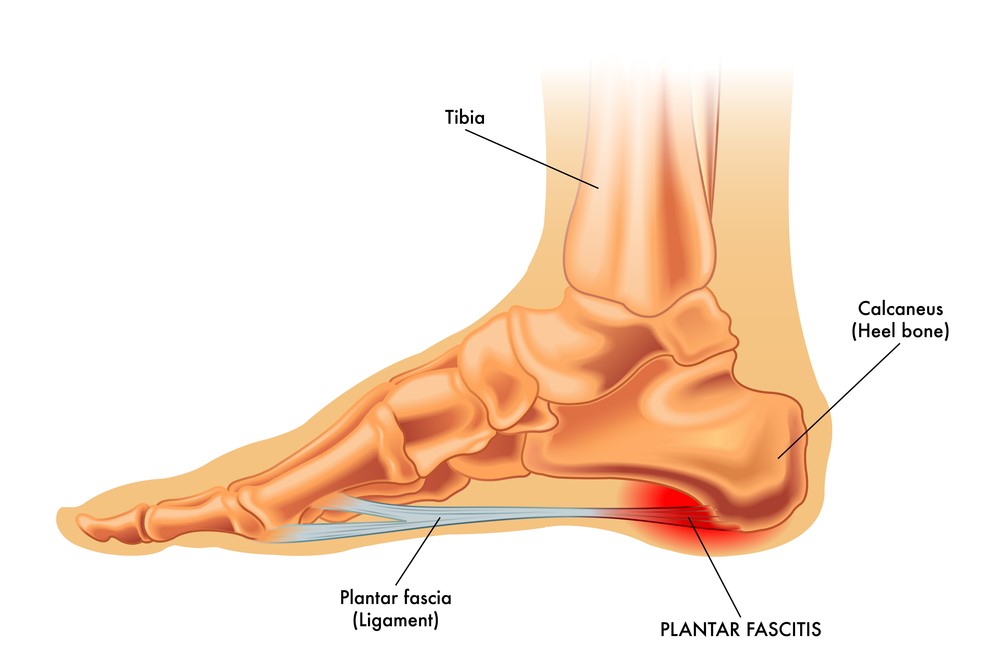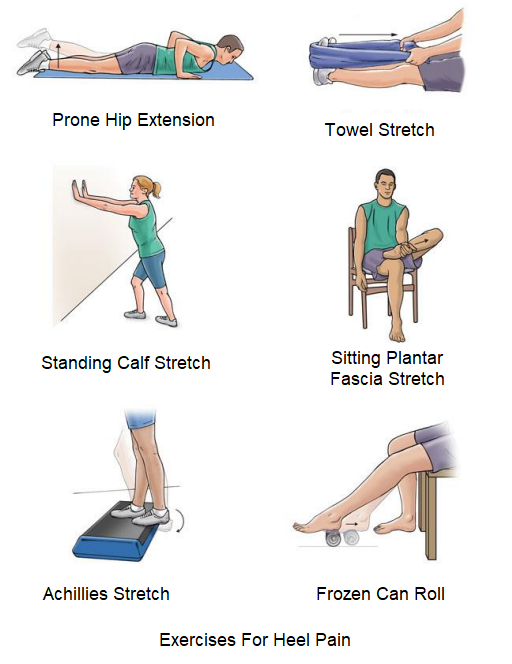
Foot pain when walking can be caused by a wide range of conditions, such as plantar fasciitis, flat feet, bunions, arthritis, or injury.
Some of the causes of foot pain are – Achilles tendinitis, Achilles tendon rupture, Avulsion fracture, Bone spurs, Broken foot, Broken toe, Bunions, Bursitis (joint inflammation).
Foot Bath To alleviate foot pain, a warm foot bath can be highly effective. Incorporating Epsom salts into the bath can aid in relieving sore muscles and reducing swelling in the feet. While some may consider adding baking soda to the soak, it is more effective in addressing skin-related conditions than soreness or swelling. To create an Epsom foot bath, simply add one cup of Epsom salts to a tub of warm water. Soak your feet in the mixture for approximately twenty minutes to experience relief.

Foot Stretches To alleviate foot soreness, you may also want to incorporate some foot pain exercises into your routine. You can focus on specific areas of your foot, such as your toes or heel, or perform a variety of stretches to target your entire foot. These exercises can aid in preventing cramps and improving flexibility. Here are a few examples:
Repeat the following toe exercise ten times: flex your toes, point them, and then curl them for several seconds.
Warm up your feet by sitting down and extending your legs before foot pain relief exercises. Move your toes around, point them towards and away from your body, and rotate your ankles in both clockwise and counter clock wise directions.
To continue stretching your feet, shift your weight from your heels to your toes while standing. Alternate lifting the front and back of your feet off the ground.
Strengthening Exercises Performing strengthening exercises is important in maintaining flexible and pain-free feet. Regular walking is a great way to keep your feet healthy and mobile, so it's recommended to avoid leading a sedentary lifestyle. If you're unsure whether you're walking enough, you can use a pedometer to track your daily steps and ensure that your feet are staying active.
Additionally, resistance exercises can help build strength in your feet and reduce the
risk of future soreness. You can incorporate resistance bands, weights, or even your
body weight into your exercises. Here are a few exercises to try:
Massage
One way to alleviate foot pain is by giving yourself a foot massage. Find a comfortable
chair to sit in and use your hands to rub and knead the soles of your feet. Don't forget
to stretch and massage your toes by pulling them apart and bending them. Using lotion or
oil can help to lubricate your skin, making the massage more comfortable.
Another
option is to use foot rollers, which are textured cylinders that can be rolled on the
floor using your feet to massage them. This can be a great way to relieve tension and
promote relaxation in your feet.
Right Shoes Your foot discomfort could be a result of your shoes. Wearing shoes that are too old, inappropriate for your foot type, or an incorrect size can impact your foot health. Your sneakers may lose their support and cushioning after 400 to 500 miles of use, leading to foot pain. High heels and shoes without adequate arch support, such as flip-flops, can harm your feet. Your feet can expand in size throughout your life, even when you are an adult, due to natural changes. To alleviate foot pain, consider investing in new shoes that fit well and provide appropriate arch support. Wearing shoes appropriate for the activity you're doing is also essential, such as wearing athletic shoes when exercising.
Arch Flat foot treatment will need arch supports, which can help to stabilize your feet while standing or walking, thereby reducing pain. You can find them in stores or have them custom-made by a doctor. Both options are effective in relieving rear foot pain and improving the overall function of your feet. flat feet treatment.
Over-the-counter pain relievers such as acetaminophen can be effective in treating pain, while nonsteroidal anti-inflammatory drugs (NSAIDs) like ibuprofen and naproxen sodium can also help to reduce both pain and inflammation. It is important to note that if you are experiencing long-lasting foot inflammation, it may take several weeks of regular medication use to fully alleviate your symptoms.
To treat the symptoms of burning feet, patients can try cold water baths, Epsom salts, turmeric supplements, and fish oil as home remedies for burning feet.
Vitamin deficiency: Taking vitamin B12 supplements orally or through injections can help replace low levels of this nutrient and help treatment for neuropathy in the legs and feet.
Alcoholism: Stopping excessive drinking can prevent ongoing nerve damage and allow nerves to heal.
Chronic kidney disease: Dialysis may be necessary to eliminate toxins that cause neuropathy and burning feet symptoms.
Hypothyroidism: Treatment for numbness in feet by taking oral thyroid hormone can raise low thyroid levels, often reversing neuropathy and burning feet symptoms.
Acupuncture is a safe and effective treatment modality for the management of plantar fasciitis. Four studies have shown a significant reduction in pain during 4–8 weeks of therapy. At our Dr. Pardeshi Acupuncture we have been treating foot pain successfully.
“CONCLUSIONS:
There is evidence supporting the
effectiveness of acupuncture for PHP. This is comparable to the evidence available
for conventionally used interventions, such as stretching, night splints or
dexamethasone. Therefore acupuncture should be considered in recommendations for the
management of patients with PHP.”
“Our study demonstrates that acupuncture is effective in treating patients with chronic heel pain due to plantar fasciitis and that the addition of trigger point acupuncture in poor or non-responders may be useful.”
“In conclusion, this study demonstrates that acupoint PC7 has a specific effect for treatment of plantar fasciitis, and that the method of acupuncture treatment is both simple and safe.“

Our experience heel pain relief for years Nashik is very satisfactory by acupuncture Pain Therapy as narrated in heel pain treatment review
Heel pain is a prevalent foot ailment characterized by intense pain in the affected heel when in use. The pain develops gradually and worsens over time, especially when you put weight on the affected heel. While it typically affects only one heel, approximately a third of individuals experience pain in both heels. The pain is usually most severe in the morning or after a period of inactivity, improving with walking but worsening after prolonged periods of standing or walking. Some individuals may exhibit limping or adopt an abnormal gait to avoid putting weight on the affected heel.
The plantar fascia, a durable and pliant band of tissue situated under the sole, serves as a shock absorber by linking the heel bone to the foot bones.
When the plantar fascia experiences sudden or gradual damage over many months or years, it may develop small tears, known as microtears, in its tissue. This can lead to the thickening of the plantar fascia and consequent heel pain. Additionally, inflammation can also occur in the adjacent tissue and heel bone.
Heel pain can be treated with a combination of techniques, including stretches and painkillers, to alleviate pain and speed up recovery. If you experience persistent heel pain for several weeks and it hasn't cleared up, you need to see an acupuncturist or healthcare professional. They can diagnose the problem and provide specific advice about an appropriate exercise program.
Home remedies for heel pain include resting the affected foot, taking pain relief medication such as non-steroidal anti-inflammatory drugs (NSAIDs), and applying an ice pack wrapped in a towel can also help relieve pain and inflammation.
Various stretching exercises can serve as plantar fasciitis treatment at home. Exercise as a heel pain remedy can help improve flexibility and relieve pain. Relief for heel pain can be achieved by acupuncture therapy.
Wearing shoes that cushion the heels and provide arch support, as well as using orthoses, strapping, and splinting, can also aid in plantar fasciitis treatment. Heel pain homeopathic medicine and ayurvedic treatment of heel pain have also been reported to have encouraging results. Surgery may be recommended as a last resort for calcaneal spur treatment or heel spur treatment if symptoms do not improve after 12 months, but only one in 20 people with heel pain will require surgery.
Acupuncture may help plantar fasciitis, a common cause of heel pain. We Dr. Pardeshi Acupuncture we have been treating plantar fasciitis regularly with very good results.
The ankle joint is the meeting of the bones of the leg and the foot and is responsible for the up and down motion of the foot. In ankle pain, symptoms, and swelling go side by side. A sore ankle is generally associated with stiffness. Ankle bone pain may present with discoloration of the ankle. Whether there is ankle pain inside or ankle pain outside depends upon the site of injury.
Pain in the ankle can due may be an injury, arthritis, flat foot, and other diseases, and pathology with bones, ligaments, tendons, muscles, fascia, toenail beds, nerves, blood vessels, or skin. The ankle is often considered to be the ankle joint plus the surrounding anatomic region, including the lower end of the leg and the start of the flat part of the foot.
High impact to the heel may cause fracture of heal bone—like when a person has fallen from a height or been in a car accident. Injuries can be a bone crack due to vigorous exercise to a shattered bone from a high fall. Ankle injuries can be a sprain of ligaments or strain of tendons or muscles. Ankle pain after a sprain can vary according to the severity of the injury. Severe ankle pain can result due to a tear of muscle or ligament. Achilles heel pain can be due to ankle tendonitis. Tendonitis can cause foot and ankle pain.
Ankle Arthritis: Ankle joint pain is sometimes associated with a swollen foot. Ankle pain swelling may be warmer than the rest of the tissue. Toe pain is common in arthritis of the ankle.
“Acupuncture – clinical studies have shown acupuncture to be effective in treating ankle pain associated with conditions directly related to the ankle as well as referred pain from other parts of the body that affect the ankle and feet.”
“Results from this meta-analysis provide evidence that WAA or WAA adjuvant helps patients relieve pain and is a quite safe therapy. Besides, WAA is a cheap and convenient treatment. Doubtless, it is good for the substantial number of people suffering from pain. Also, WAA deserves from health policy makers to pay more attention and it is worthy of clinical promotion.”
“the results are sufficiently encouraging to suggest that metatarsalgia may be treated by acupuncture alone and to warrant a trial comparing the effectiveness of these differing conservative treatments”
Rest: Avoid putting weight on the affected ankle and limit physical activity until it heals.
Ice: Apply ice to the ankle for 20 minutes every 2–3 hours to help reduce swelling.
Compression: Wrap compression bandages and dressings around the painful ankle.
Elevate: Keep the ankle elevated to reduce swelling.
Medications: Take paracetamol.
Acupuncture: It may give instant relief.
Medications: Take paracetamol.
Rest: Avoid putting weight on the affected ankle and limit physical activity until it heals.
Compression: Wrap compression bandages and dressings around the painful ankle.
Ice: Apply ice to the ankle for 20 minutes every 2–3 hours to help reduce swelling.
Elevate: Keep the ankle elevated to reduce swelling.
Acetaminophen and NSAID drugs can be taken but the effect is temporary. Acupuncture can provide a lasting effect.
Plantar Fascia Massage. You should not experience pain during this exercise. Heel Raise. Floor Sitting Ankle Inversion with Resistance. Seated Toe Towel Scrunches. Seated Plantar Fascia Stretch. Wall-Facing Calf Stretch.